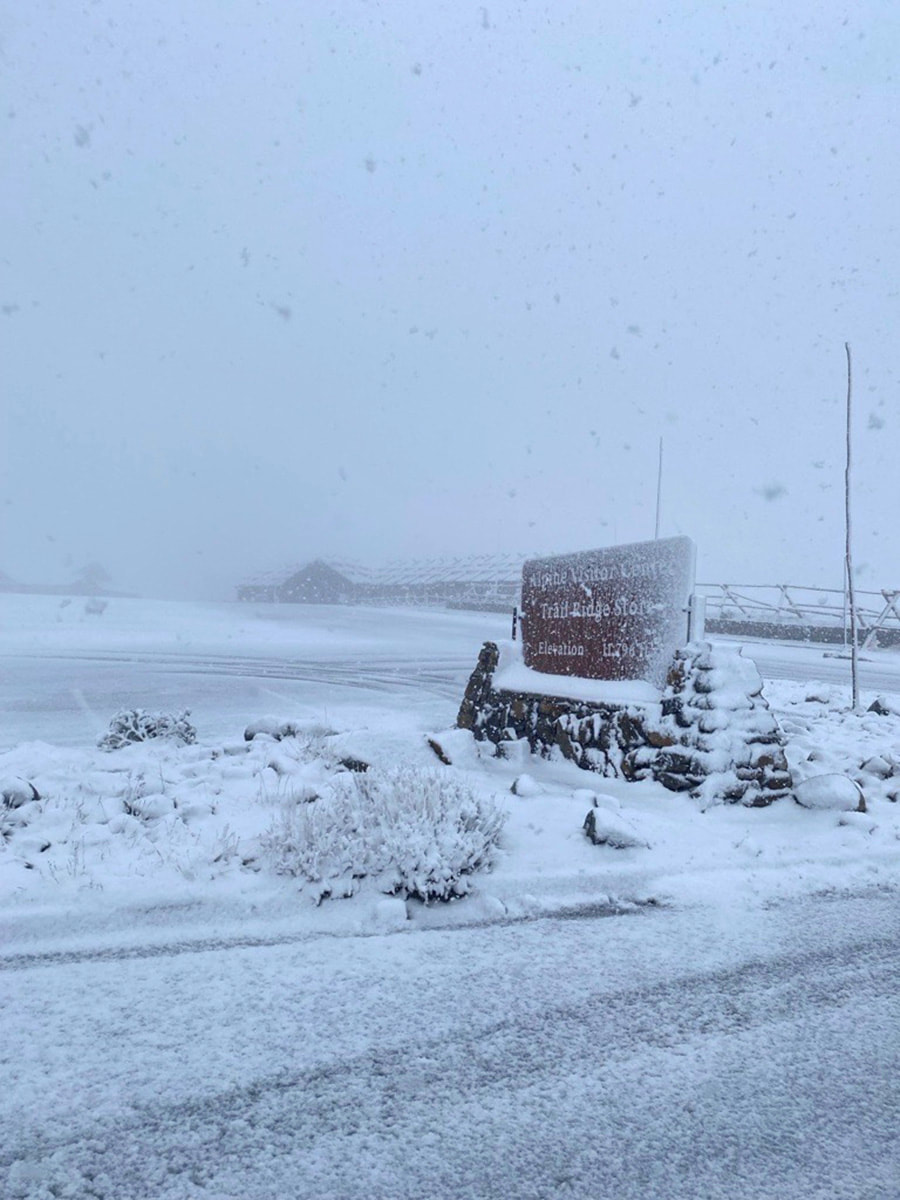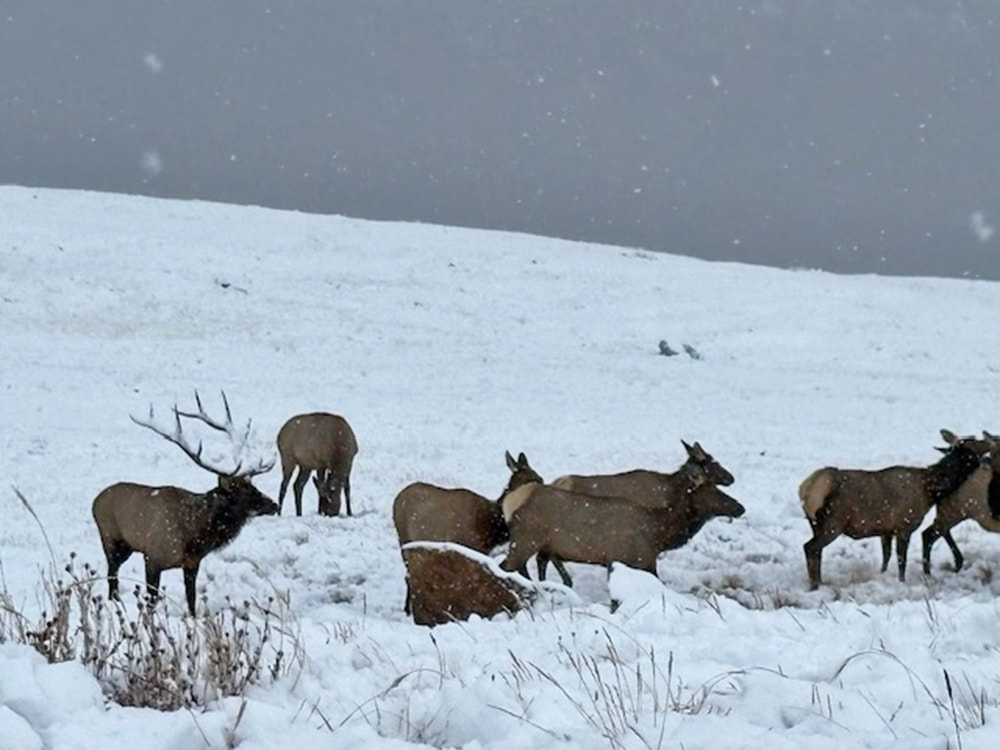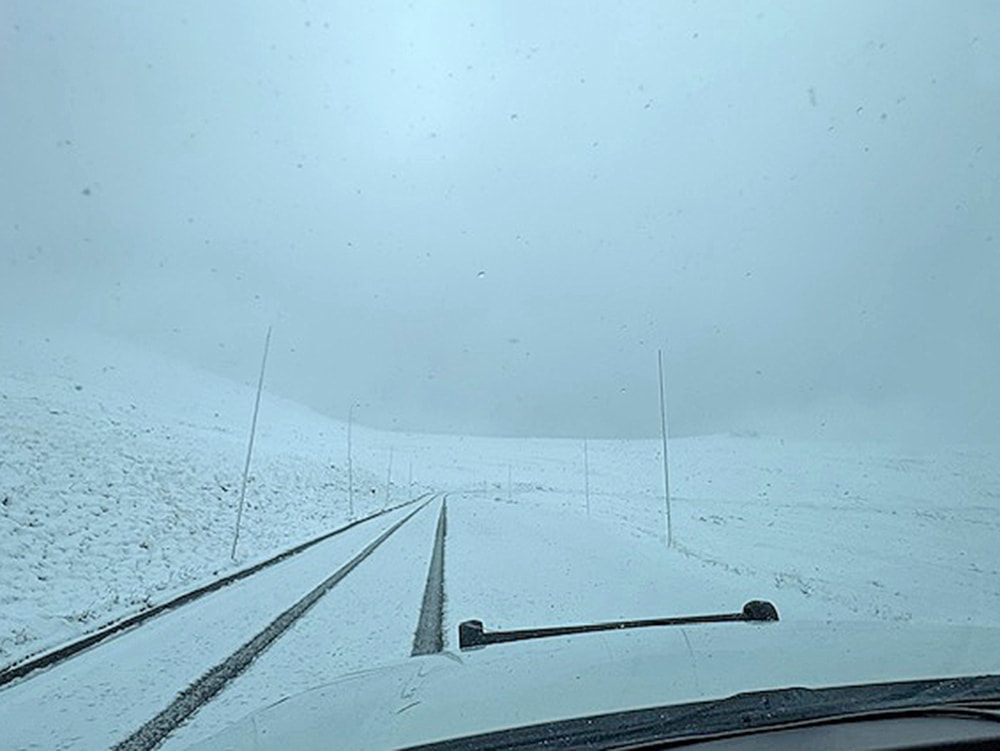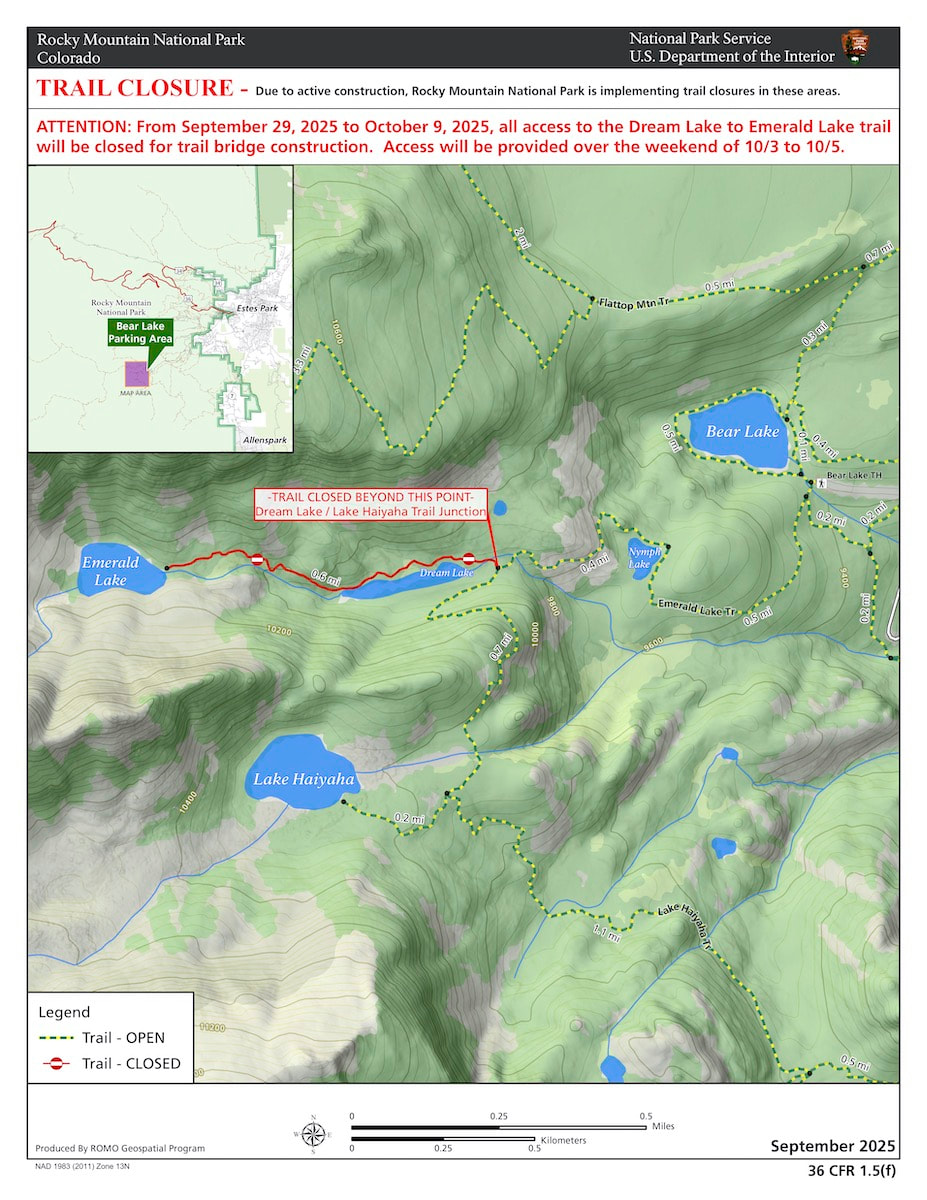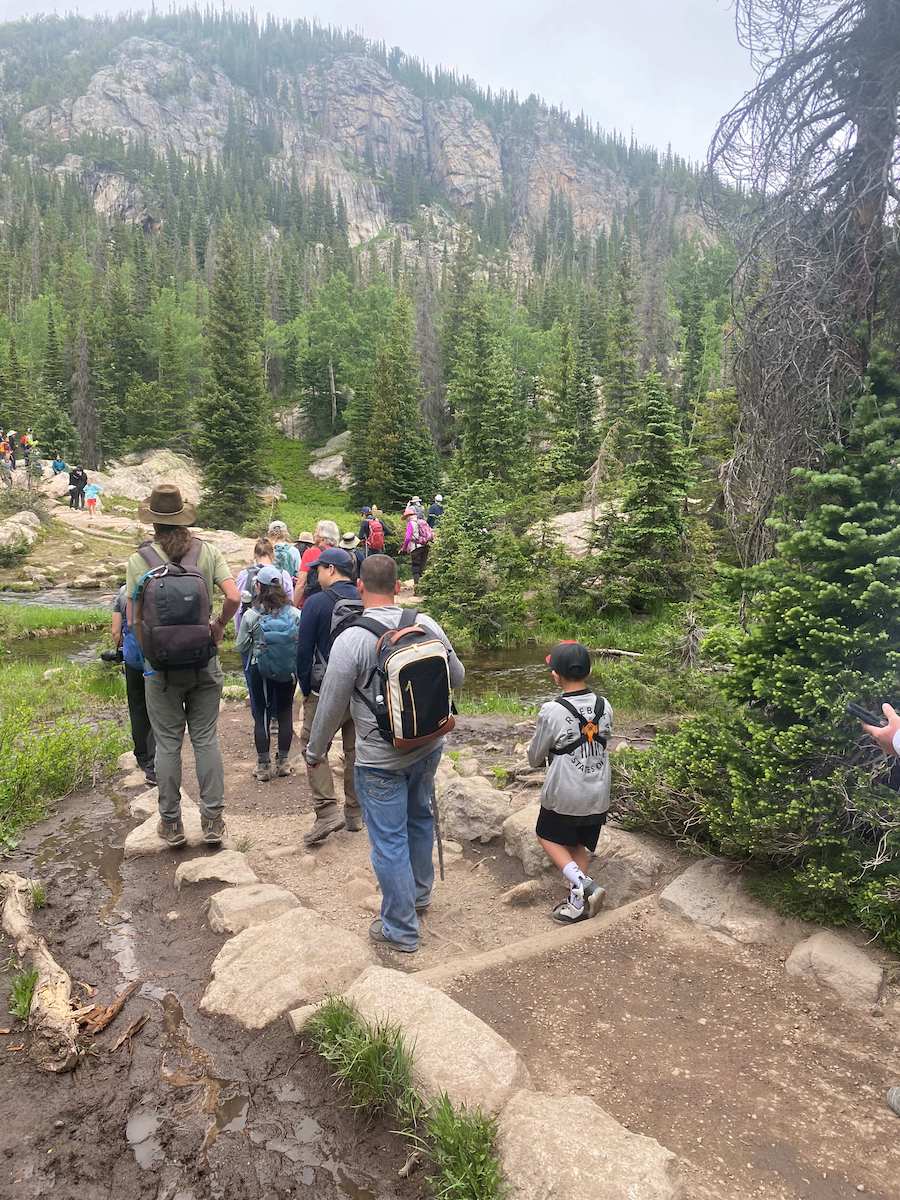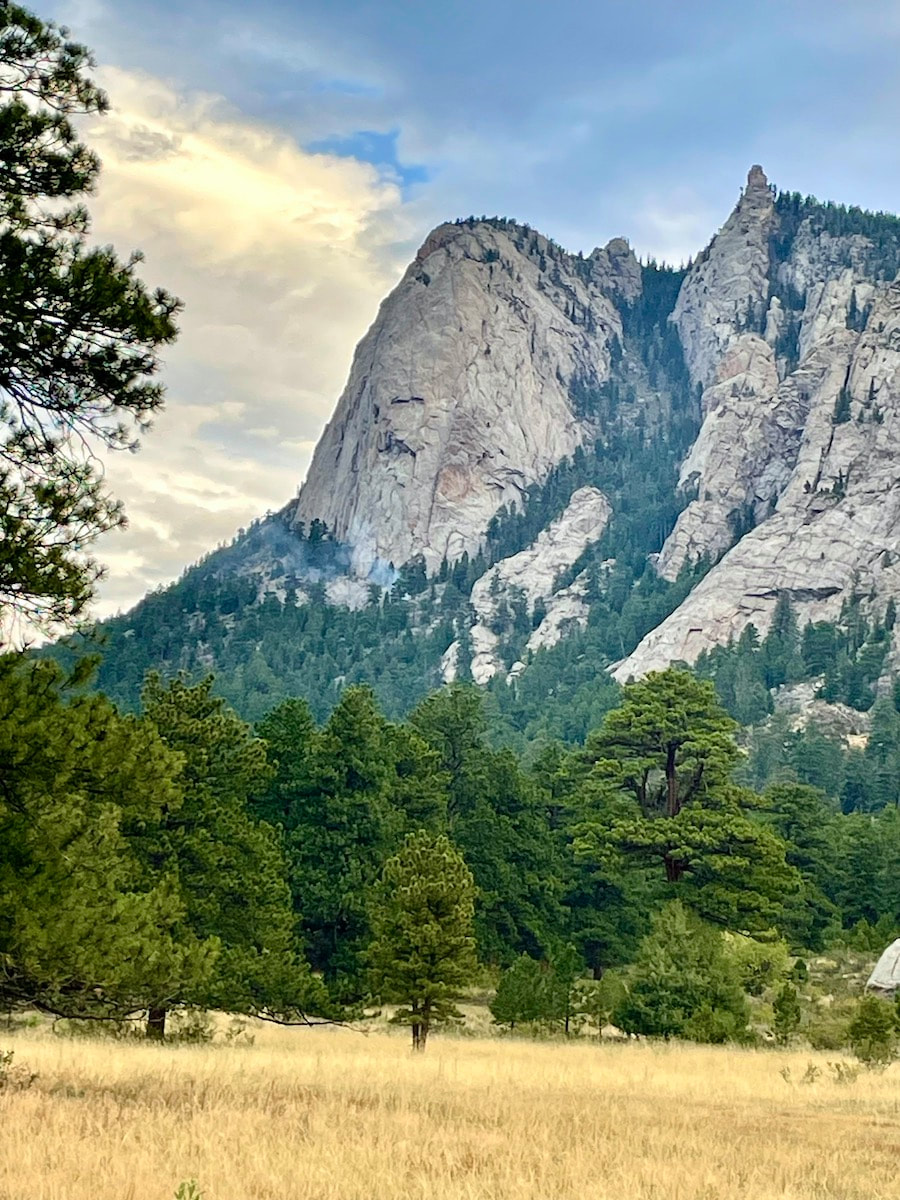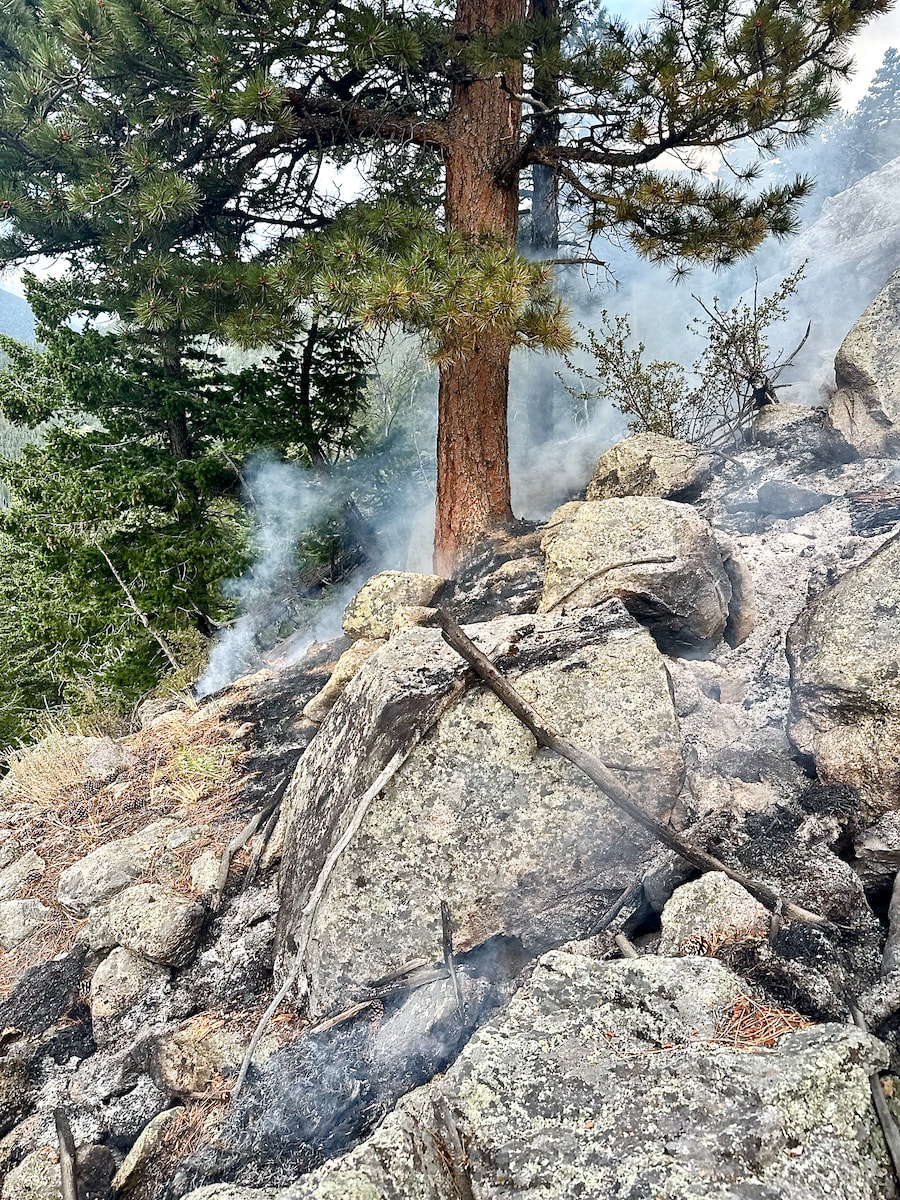Photographs of snow along higher elevations of Trail Ridge Road in Rocky Mountain National Park9/23/2025 It is currently snowing in the high elevation areas of Rocky Mountain National Park. Snow started to fall at Alpine Visitor Center around 5 p.m. last night and it is still snowing in areas above 10,000 feet in elevation. In the lower elevation areas of the park, on both the east and west sides, expect rain today.
Trail Ridge Road is temporarily closed to thru travel. The road is closed on the east side of the park at Rainbow Curve and on the west side of the park at Colorado River Trailhead. Old Fall River Road is also temporarily closed. Rangers will assess road conditions tomorrow. For updates on the status of Trail Ridge Road, call the recorded status line at 970-586-1222, follow us on the park's official social media pages, and check for alerts on the park's webpage at https://www.nps.gov/romo/index.htm.
0 Comments
Beginning Monday, September 29 through Thursday, October 2, and then again Monday, October 6 through Thursday, October 9, trail access to Dream Lake and Emerald Lake will be closed to all uses for an outlet bridge replacement project. Dream Lake and Emerald Lake will not be accessible during these days. This popular trail section will reopen Friday through Sunday (October 3 through October 5) and close again on Monday, October 6.
All other trails in the Bear Lake area will remain open including the trail to Lake Haiyaha from Nymph Lake. For more information about Rocky Mountain National Park, visit www.nps.gov/romo or call the park Information Office at (970) 586-1206. Beginning on Monday, September 1, annual meadow closures will go into effect in Rocky Mountain National Park to prevent the disturbance and harassment of elk during their fall mating season. Meadow closures are also in place for safety and enjoyment of park visitors who are enjoying wildlife viewing during the elk rut season.
Meadow closures will be in place between the hours of 5 p.m. to 10 a.m. Areas that are closed include meadow areas in Horseshoe Park, Upper Beaver Meadows, Moraine Park, Harbison Meadow and Holzwarth Meadow. During the specified hours, these meadow areas will be closed to all travel on foot or via horseback off established roads and trails. Meadow closures will remain in effect through October 31, 2025. Fishing locations along the Fall River, Thompson River, and Colorado River that are accessed by walking through closed meadow areas are closed to fishing between the hours of 5 p.m. to 7 a.m. Wildlife viewing is one of the most popular activities that visitors enjoy each fall. Keep your distance and view wildlife with respect. When viewing elk keep back at least 75 feet (23 m). This is the length of two school buses. It is our responsibility to keep our distance. Don’t keep approaching wildlife until they react to you. As always, elk calling and the use of spotlights or vehicle headlights for spotting wildlife is prohibited within Rocky Mountain National Park. Rocky Mountain National Park will be releasing additional campsite reservations at Moraine Park Campground beginning on Thursday, August 28 at 8 a.m. Mountain Time, for reservations for September 10 through September 27. Reservations will be available through www.recreation.gov.
The campground will close on September 28 to complete a few remaining construction items and is planned to reopen for winter camping opportunities on a first come, first serve basis on October 20. The Moraine Park Campground and Utility Rehabilitation Project is a critical infrastructure project that is improving water, wastewater and electrical distribution systems that serve not only Moraine Park Campground, but also Beaver Meadows Visitor Center and Rocky Mountain National Park’s headquarters area and many other critical park facilities. For more information about Rocky Mountain National Park, visit www.nps.gov/romo or call the park Information Office at (970) 586-1206. Rocky Mountain National Park fire crews responded this morning to visitor reports of smoke in an area above Mills and Jewel Lakes close to treeline. Crews hiked to the area below the smoke and confirmed the location of the small fire.
Due to steep and technical terrain where the fire was located, air resources were requested. The Mills Lake trail was temporarily closed while Northern Colorado Helitack dropped buckets of water, dipped from Jewel Lake, on the small fire. The trail has reopened. It is currently raining on the fire and is forecast in the area today and tonight. Fire crews will continue to take appropriate suppression efforts. The cause is currently undetermined. Early this morning park fire managers were notified of a fire in the area below the Needles in the Lumpy Ridge area. Fire crews are on scene for this .2 acre (2/10 acre fire). Cause is under investigation and appears to be lightning caused. The Estes Valley Fire Protection District has been providing resources since early this morning. Smoke may be visible from Estes Park. 8/18-10:17am
Rocky Mountain National Park fire crews are continuing mop up operations today on the Twin Owls .30 acre (3/10 acre) fire in the Lumpy Ridge area. Fire managers are working with a Douglas County Type 2 helicopter to transport water bags for park fire crews to extinguish the remainder of any duff. The area of this small fire is surrounded by rock. Helicopter operations will continue to be visible this morning in this area. 8/17-4:09 pm Fire crews have a containment line around the approximate .30 acre (3/10 of an acre) fire and are conducting mop up operations which includes extinguishing any remaining heat or burning material near the fire perimeter. The cause of the fire is lightning. 8/17-1:33pm Rocky Mountain National Park fire crews are on scene in the Lumpy Ridge area of the park for a small fire. The fire is approximately 1/10 acre in size. The Estes Valley Fire Protection District is also providing resources. Smoke may be visible from Estes Park. This morning, park rangers were notified that a 26-year-old male climber had taken a roped fall on the South Face of Petit Grepon in Rocky Mountain National Park (RMNP), resulting in lower leg injuries. With the help of his partner, the climber was able to rappel to the base of the route where a hasty team of park rangers provided medical care.
Meanwhile, a RMNP Search and Rescue litter team carried equipment to the base of Timberline Falls for a possible guiding line operation. At 3 p.m. park rangers were assisted by a Colorado Army National Guard helicopter from Buckley Space Force Base to extricate the man via a hoist operation. Colorado Hoist Rescue Team assisted with helicopter hoist operations. The man was taken to further medical care from Upper Beaver Meadows. No further information is available at this time. On Wednesday, August 13, a body believed to be that of Blake Kieckhafer, 23, of Omaha, Nebraska, was recovered above Emerald Lake. Rocky Mountain National Park rangers completed an on-scene investigation and recovery operations took place by helicopter. His body was flown to a landing zone in Rocky Mountain National Park and transferred to the Larimer County Coroner’s Office. Kieckhafer was reported missing to park rangers by family on Monday, August 11. He was last seen in the Upper Beaver Meadows area of Rocky Mountain National Park on Thursday, August 7 around 5:20 p.m. when he was dropped off by a ride share service. Investigations lead to search efforts being focused in the Emerald Lake area on Wednesday. Over 80 people were involved in yesterday’s search efforts. Several agencies and organizations assisted Rocky Mountain National Park Search and Rescue Team members with efforts including Larimer County Search and Rescue Dog Teams, Arapaho Rescue Patrol and a contracted helicopter with Trans Aero. The Larimer County Coroner’s office will confirm positive identification of the individual and release additional information. Rocky Mountain National Park rangers began search efforts for Blake Kieckhafer, 23, of Omaha, Nebraska. Kieckhafer was reported missing to park rangers by family on Monday, August 11. He was last seen in the Upper Beaver Meadows area of Rocky Mountain National Park on Thursday, August 7 around 5:20 p.m. when he was dropped off by a ride share service. Upper Beaver Meadows Road is located approximately 1-mile west of Beaver Meadows Entrance along U.S. Highway 36 on the east side of the park.
Kieckhafer was last seen wearing a dark-colored T-shirt, dark-colored pants, and a dark-colored baseball cap with no logo. He was carrying a small, maroon daypack. Kieckhafer is described as 5’11,” 180 pounds, with buzzed/short blonde hair and a mustache, and blue/green eyes. If you have information that could help investigators or if you have seen Blake Kieckhafer, please contact us. You don't have to tell us who you are, but please tell us what you know. CALL or TEXT the National Park Service Investigative Services Bureau Tip Line 888-653-0009, ONLINE at https://go.nps.gov/SubmitATip, or EMAIL [email protected] |
RMNP UpdatesPress Releases from Rocky Mountain National Park and the Rocky Mountain Conservancy.
Archives
September 2025
|
© Copyright 2025 Barefoot Publications, All Rights Reserved

